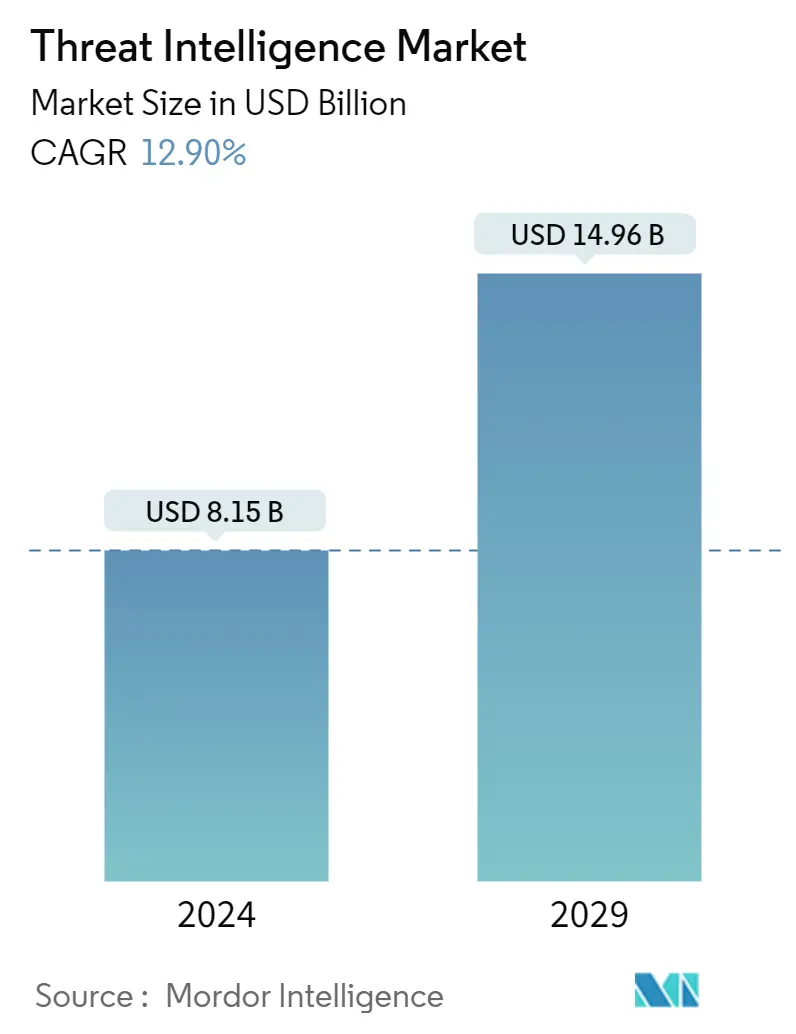Market Size of Threat Intelligence Industry

| Study Period | 2019 - 2029 |
| Market Size (2024) | USD 8.15 Billion |
| Market Size (2029) | USD 14.96 Billion |
| CAGR (2024 - 2029) | 12.90 % |
| Fastest Growing Market | Asia Pacific |
| Largest Market | North America |
Major Players
*Disclaimer: Major Players sorted in no particular order |
Threat Intelligence Market Analysis
The Threat Intelligence Market size is estimated at USD 8.15 billion in 2024, and is expected to reach USD 14.96 billion by 2029, growing at a CAGR of 12.90% during the forecast period (2024-2029).
A paradigm shift has taken place in the last few years between attack sources, targets, destination attacks profiles and different types of technology. While it is possible to identify attack types and targets, the source of those attacks remains a problem due to difficulties in determining who was responsible for them.
- Organizations are shifting their focus to different cyber security solutions in view of the increasing number of attacks and data breaches. Due to the increasing cyber arms race among attackers and defenders, a growing number of organisations are focusing their attention on cyber intelligence. Thanks to threat intelligence, defenders have been able to make quicker and more informed security decisions with a view to moving their behaviour from reactive to proactive in the event of an attack.
- Most organizations focus their intelligence efforts on more basic use cases, which are based on existing case studies and attacks, such as integrating intelligence feeds with existing IPS, firewalls and SIEMs, and do not take full advantage of the intelligence information they have to offer.
- The market for threat intelligence is primarily driven by the increasing uniqueness of the attack techniques, which makes the data vulnerable. The key factor driving this market is the increasing volumes of data generated by different enterprises.
- By integrating cloud and threat intelligence, organisations can protect themselves against cyber threats by using the Global Threat Community to detect unknown threats before they become known in order to prevent them from emerging so as to target an attack's surface. This has led to a significant increase in the adoption of threat intelligence solutions.
- The number of cyber crimes has increased in recent years, but there is no sign they are slowing down. telecommuting has increased as a result of the pandemic. The number of cyberattacks is increasing. The market for threat intelligence is further driven by the adoption of a remote working model by enterprises, which raises concerns about corporate security.
- The COVID 19 pandemic has had a positive impact on market growth, and new strategies are being developed by governments around the world to support organisations' concerns about cyber security. An increase in cyber vulnerabilities is driving the growth of threat intelligence markets.
Threat Intelligence Industry Segmentation
Threat intelligence collects and evaluates information relevant to protecting an organization from internal and external threats and analyzes that information to detect deceptions for accurate and relevant intelligence.
The threat intelligence market is segmented by type (solutions and services), deployment (on-premise and cloud), end user (banking, financial services, and insurance (BFSI), IT and telecom, retail, manufacturing, healthcare), and geography (North America (United States, Canada), Europe (United Kingdom, Germany, France, Rest of Europe), Asia-Pacific (China, Japan, India, Australia, Rest of Asia-Pacific), Latin America (Mexico, Brazil, Rest of Latin America), Middle East and Africa (United Arab Emirates, South Africa, Rest of Middle East and Africa)). The market sizes and forecasts are provided in terms of value (USD) for all the above segments.
| By Type | |
| Solutions | |
| Services |
| By Deployment | |
| On-premise | |
| Cloud |
| By End-user Industry | |
| BFSI | |
| IT and Telecommunications | |
| Retail | |
| Manufacturing | |
| Healthcare | |
| Other End-user Industries |
| By Geography | |||||||
| |||||||
| |||||||
| |||||||
| |||||||
|
Threat Intelligence Market Size Summary
The threat intelligence solutions market is experiencing significant growth, driven by the increasing complexity and frequency of cyberattacks. Organizations are increasingly prioritizing cyber intelligence to enhance their security posture, shifting from reactive to proactive measures. This shift is largely due to the evolving nature of cyber threats, which have become more sophisticated and targeted. The integration of threat intelligence with existing security infrastructure, such as firewalls and SIEMs, is becoming more prevalent, although many organizations are still not fully leveraging the potential of the intelligence available to them. The rise in remote working models, accelerated by the COVID-19 pandemic, has further underscored the need for robust threat intelligence solutions to safeguard corporate security.
The financial services sector, in particular, is a major driver of the threat intelligence market due to its vast customer base and the sensitive nature of the data it handles. Cybercriminals frequently target this sector with various attack vectors, including malware and data breaches, making it imperative for financial institutions to adopt advanced security measures. The market is also seeing increased investment in research and development to develop sophisticated threat intelligence solutions, supported by both public and private sector initiatives. Key players in the market, such as Dell Inc., IBM Corporation, Anomali Inc., Fortinet Inc., and CrowdStrike Inc., are continuously innovating and expanding their offerings to address the growing demand for effective threat intelligence solutions.
Threat Intelligence Market Size - Table of Contents
-
1. MARKET INSIGHTS
-
1.1 Market Overview
-
1.2 Industry Attractiveness - Porter's Five Forces Analysis
-
1.2.1 Threat of New Entrants
-
1.2.2 Bargaining Power of Buyers/Consumers
-
1.2.3 Bargaining Power of Suppliers
-
1.2.4 Threat of Substitute Products
-
1.2.5 Intensity of Competitive Rivalry
-
-
1.3 Industry Value Chain Analysis
-
1.4 Assessment of Impact of COVID-19 on the Market
-
-
2. MARKET SEGMENTATION
-
2.1 By Type
-
2.1.1 Solutions
-
2.1.2 Services
-
-
2.2 By Deployment
-
2.2.1 On-premise
-
2.2.2 Cloud
-
-
2.3 By End-user Industry
-
2.3.1 BFSI
-
2.3.2 IT and Telecommunications
-
2.3.3 Retail
-
2.3.4 Manufacturing
-
2.3.5 Healthcare
-
2.3.6 Other End-user Industries
-
-
2.4 By Geography
-
2.4.1 North America
-
2.4.1.1 United States
-
2.4.1.2 Canada
-
-
2.4.2 Europe
-
2.4.2.1 United Kingdom
-
2.4.2.2 Germany
-
2.4.2.3 France
-
2.4.2.4 Rest of Europe
-
-
2.4.3 Asia-Pacific
-
2.4.3.1 China
-
2.4.3.2 Japan
-
2.4.3.3 India
-
2.4.3.4 Australia
-
2.4.3.5 Rest of Asia-Pacific
-
-
2.4.4 Latin America
-
2.4.4.1 Mexico
-
2.4.4.2 Brazil
-
2.4.4.3 Rest of Latin America
-
-
2.4.5 Middle East and Africa
-
2.4.5.1 United Arab Emirates
-
2.4.5.2 South Africa
-
2.4.5.3 Rest of Middle East and Africa
-
-
-
Threat Intelligence Market Size FAQs
How big is the Threat Intelligence Market?
The Threat Intelligence Market size is expected to reach USD 8.15 billion in 2024 and grow at a CAGR of 12.90% to reach USD 14.96 billion by 2029.
What is the current Threat Intelligence Market size?
In 2024, the Threat Intelligence Market size is expected to reach USD 8.15 billion.

